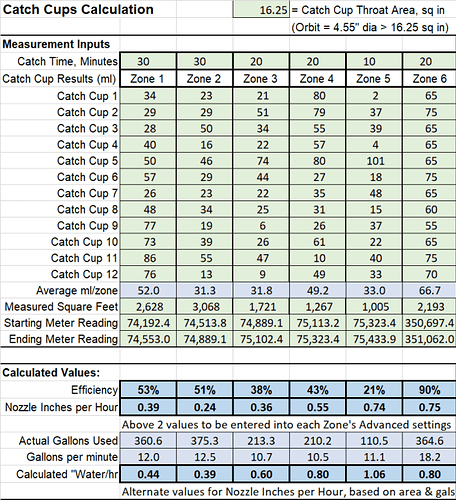I’m getting more and more familiar with my Rachio 3 and all the Zone attributes that determine how my Flex Daily schedule works. Enough to know that one of the most important things to get right is, for each zone, the “Nozzle Inches per Hour” (which actually has nothing to do with individual nozzles, but is actually the inches of water applied by your system, on average, to the zone in question. Which I moved into my new home about 6 years ago, I did my own spreadsheet and calculations, and measured the time to deliver 1 cubic foot of water (7.48 gallons). I then took the area of each zone (I’d drawn my house using a CAD system, so these were easy to measure), used it to calculate the inches per hour. When I got my Rachio, I used this by default, but thought I needed a more accurate method.
So, I bought the Oribit catch cups, and finally got around to doing the test yesterday. Due to the 97 degree heat and my 77 years of age, I got my son to help. I also made up a spreadsheet to enter the values into, to calculate my Nozzle Inches per Hour, which I thought I knew, along with the Efficiency (a measure of how evenly the system distributes the water), which I’d only been using the defaults for. I’ll give a link to the spreadsheet I used, so anyone interested can download it, but here’s what I ended up with:
It seems that I have a rather irregularly shaped lawn, and zones, and that my irrigation contractor didn’t care much about what he was doing. The values of water in each of the catch cups differed wildly: Zone from 26 to 86, Zone 5 (a completely rectangular zone), 2 to 101. My efficiencies ran from a high of 53% to a low of 21%! I also calculated the Nozzle Inches per Hour, which I needed for my zones, and since I had the areas, recorded the water used from my meter and calculated a separate set of Inches per Hour from it. They vary widely!
(Zone 6 is not my measurement; I entered data for that zone from a spreadsheet previously posted here by ajardolino3. HIS values are great: His efficiency is 90%, and the Nozzle Inches per Hour matches the flow rate calculating within 0.05".)
Anyhow, I now consider my catch cup results pretty much worthless. The main thing they do is show me the problems and inadequacies of my irrigation system. And without starting over, and spending a BUNCH of money, that probably won’t be fixed. On my system, the water received at any given location can double, or halve, less than six feet away.
So, I’m back to using inches per hour calculated by reading the water used over a given time, and the area of the zone. That was pretty straightforward, except where two of the zones overlap. I fudged the values around until I’m pretty comfortable with the results, so have no entered those values for Nozzle Inches per hour into those zones. And rather than use the horrible Efficiency values I’ve calculated, I entered 70% back in for all zones. Despite the obvious layout problem of the sprinkler heads, my yard has few very dry or very wet spots (some bare spots get as much water as lush ones), so don’t want to add /too/ much water compared to what I’m doing now.
Anyhow, I wish anyone doing this better luck, or at least, better results, than I had in my catch cup test. And whether you are using catch cups, or calculating based on area, the spreadsheet I’ve created may help you. Right now, the spreadsheet has a few limitations:
- You must use 12 catch cups per zone.
- You can enter only a total of 6 zones (but can make multiple spreadsheets to cover more).
- It is designed to work with Orbit catch cups, but you can enter a different cup area if desired.
- I use the milliliter scale for reading the catch cups, as it’s easiest to get accurately.
- The water meter reading must be in gallons.
- You can estimate your zones’ areas using the DaftLogic Area Tool.
- The Excel spreadsheet is protected, to prevent overwriting formulas, but has no password, so those who are familiar with Excel can modify it themselves.
You can download the spreadsheet here: Irrigation Catch Cups Spreadsheet.
If anyone has other requirements, let me know and I can possibly accommodate them. And if you find any problems or errors, please let me know.

